It was the profoundly pessimistic, mad, hopeless, irredeemable, almost insane world of Hieronymus Bosch. Very few paintings in the history of art have so puzzled viewers as the enigmatic, “The Garden of Earthly Delights”; in our own hedonistic, instantly gratifying and equally troubling times, it is still difficult to discern and tag the work with a clear and transparent meaning or set of meanings that would identify specific follies that that Bosch has depicted. The message is a bit blood chilling….
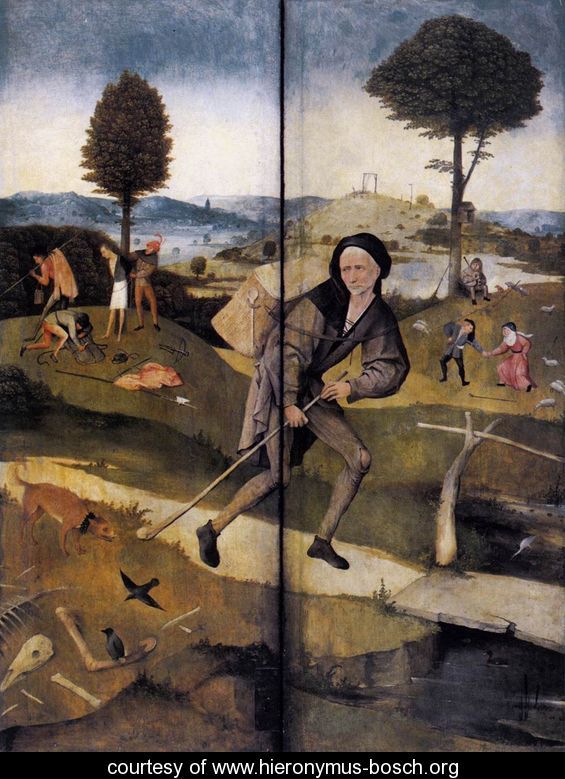
The Haywain. Cover panel. "The Way of Life." "Four aspects characterize Benjamin's position. First, paradise is the origin of man, and it is also utopian vision of his future redemption. Secondly, there is actually no real progress, and the angel does not deviate from this course of "one continuos disaster." Thirdly, genesis implicitly included its final goal: creation, or paradise, already contained the seed of disturbance. Fourthly, all this does not imply that there is no room for redemption, but only that redemption has to appear "from the outside" as the interruption of history, and it does not take an imminent part in history. At the end of modernity this image of redemption serves the philosopher as a necessary postulate in the struggle for the salvation of his soul. These aspects also characterize Horkheimer's later thoughts. However, his metaphysics is less explicit. " Read More: http://construct.haifa.ac.il/~ilangz/Utopia4.html
A general drift of the message is that God’s original creation of angels and humankind became a kind of Frankenstein when released out of captivity; something went awfully wrong that even the Savior, and his act of redemption through his sacrifice on the cross was proved to be totally useless and a complete waste of time. There is an antagonistic relationship between Bosch and God based on the idea that humankind, in spite of God, is determined to go to hell.
Both Bosch’s the Haywain and The Garden of Earthly Delights are triptych’s of a rather uncommon type. When an artist executes three paintings, one large picture and two flanking panels, he naturally concentrates attention on the central scene. But he usually makes the other two face inward to that scene. In these paintings by Bosch, although the intellectual emphasis remains on the center panel, the eye is meant to move from left to right, both in space and in time: from creation and Paradise long ago, through the present scene of ephemeral folly, to the infinite future in hell. Van Eyck shows eternity touching time in one glorious moment. Bosch shows the history of mankind as a long fool’s errand leading inexorably to disaster.
This, then, is the meaning of both triptych’s. Strictly speaking, they are not blasphemous and heretical. It is not heretical to portray a boozy friar or a foolish pope. However, it is heretical to declare that the incarnation of God was in vain, that Jesus failed miserably in redeeming humanity, that there is no hope of heaven, no reward for virtue, no divine grace bestowed on even a small part of mankind, and that, whatever we all do or try to do, we are traveling the primrose path to the everlasting bonfire. It is a concept hard for all but the bitterest pessimist to accept.
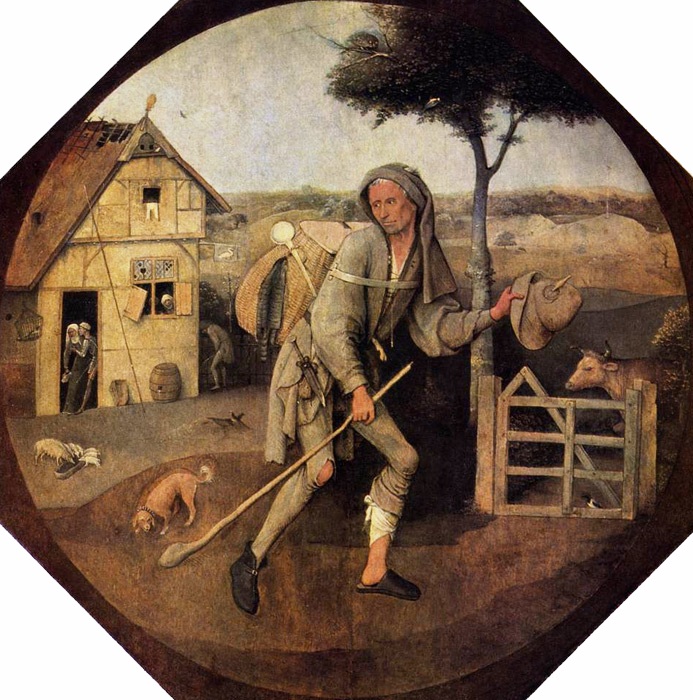
Bosch. Prodigal Son. "As we proceed it will become clear that the Master, Bosch, has not occupied himself with the ordinary outward concept of Christ's parable, but has pursued an inner spiritual meaning. Bosch sees the "son of man" in humanity as such, wandering lost about the dark earth, cut off from any connection with the spiritual world, and longing to find it again. As Bosch did not paint abstractions, he shows a person, or rather the portrait of an individual soul on the threshold of death, swaying between Good and Evil. An understanding of the portrait of the soul of this person will also allow us some insight into the man Jeroen van Aken (alias Hieronymus Bosch)." Read More: http://www.american-buddha.com/cult.hieronymusbosch.1.htm
For another reason, it is difficult to understand this message of Bosch. This is that he views sin very much as though it were mere folly. When most people contemplate human wickedness, there is a tendency to think first of cruelty and killing: Nazi death camps, Japanese atrocities again POW’s, Mexican drug wars. And when we think of other crimes, which do not destroy at once, but which corrupt; we have to ask, why go on? We seem surrounded, harassed, haunted by humanity’s inhumanity to to men, women and children. Are the decent people like Bosch’s like Bosch’s peddler in The Prodigal Son: just looking for a better place, a safer, cleaner place to live, but attacked and plagued by the devils of this world, human in face and animal in soul.
More literal violence such as abuse in Abu Ghraib prison, the slaughter of the Indians, The fire-bombing of Dresden, are fiendish and hardly human by any definition. But this aspect of man’s wickedness Bosch hardly sees. His admirer and successor Pieter Bruegel knew it well. Bruegel lived when the Spaniards were oppressing the Netherlands with fire and sword, and so he painted The Massacre of the Innocents and other scenes of strife and slaughter.
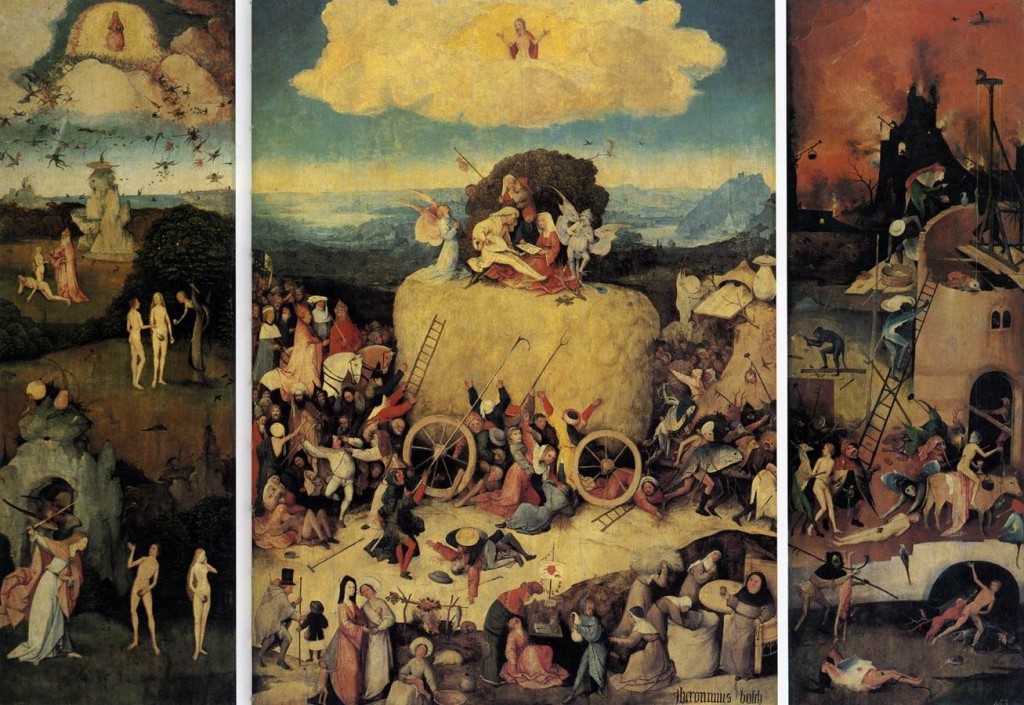
Bosch. The Haywain. "The Haywain triptych has a similar narrative to the The Garden of Earthly Delights. The left panel shows God as he creates Eve. Unlike the Garden, though, a narrative sequence flows through the panel in different scenes. At the top, the rebel angels are cast out of Heaven while God sits enthroned, the angels turning into insects as they break through the clouds. Below this, God creates Eve from the rib of Adam. Next, Adam and Eve find the serpent and the tree; the serpent offers them an apple. Finally, at the lowest part of the panel, the angel forces the two out of the Garden of Eden. Adam speaks with the angel; Eve looks ahead to the right in a melancholic pose. The central panel features a massive wagon of hay surrounded by hundreds of figures engaged in a variety of sins, not just the sin of lust which dominates the Garden of Earthly Delights" Read More: http://www.terminartors.com/artworkprofile/Bosch_Hieronymus-The_Haywain_Triptych
Hieronymus Bosch, however, considers that sin should be regarded as mere foolishness. He seldom envisages the darker aspects of sin. On earth, he will show a few men fighting or stealing; intensive cruelty and torture he places not in this world but in hell. This is because he lived and worked in a world that was, although profoundly corrupt in his sight, comparatively peaceful. There were civil disorders in the Netherlands during his lifetime, but were not seriously destructive, and the cities were growing is prosperity.
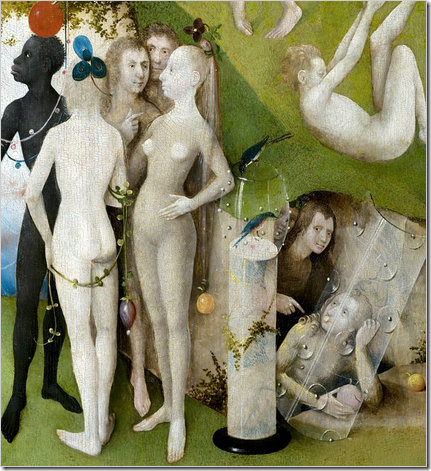
---The person behind him has the same bewildering identity. Is he John the Baptist, a "wild man" or Noah? Fraenger, in an entirely distinct approach, designated the "clothed man" as the Grand Master of the Free Spirit. This was the heretical and secret sect that Fraenger believed Bosch to belong to. The Grand Master supposedly commissioned the triptych. Fraenger elucidates: Although it might seem that we had gained enough from the historical point of view in being able to look into the face of the man who commissioned such an extraordinary work of art and inspired its intellectual conception, we can go even further and make the conjecture that this portrayal of the bridegroom is also that of the Grand Master of the Free Spirit, who meets us with a piercing, scrutinizing gaze on the threshold of his paradisical world. For when we consider such a self-confident head, that of a man whose profound knowledge of the world entitles him to occupy a position of very high authority, it is impossible to think of any other person as the head of the Brethren of the Free Spirit; and, similarly, only one who really was in the chief position of authority would be entitled to reveal their mystery - not only the community's erotic ideal, but the entire edifice of its doctrin
--Read More: http://wcoventry0.tripod.com/id17.htm image: http://lionkil.wordpress.com/What Bosch saw around him was a fat and flourishing world in which the body was hypertrophied and the spirit decaying. It was in his era that German Sebastien Brant penned the late medieval satire, Ship of Fools, which showed all sorts of conditions of men as idiots bound for the land of Stupidity. About the very time Bosch was at work on this fantastic vision, Erasmus produced an immortal ironic encomium of Folly, the deity who really , above everything else, rules mankind. The greatest paintings of Bosch seem inspired by that bitter laughter and contemptuous despair.
ADDENDUM:
William W. Coventry: This would appear to be describing the central panel. The view is from a raised position, looking down upon mankind. The scenes portrayed in the left and right panels were customary representations for his audience. No explanation was needed. For the middle panel, however, a quick look at the alluded to Psalm would be of help. Now it makes sense. Bosch is portraying the middle of the Psalm (called A hymn of joy and praise to God) as the centerpiece of his work. It is God looking down upon his work, and they are blessed. Read More:http://wcoventry0.tripod.com/id17.htm
The following verse reads He fashioneth their hearts alike; he considereth all their works. On this point, nearly all of the authors agree, Bosch represented the most of the humans in the central panel as appearing nearly identical. They are all roughly the same age and could be brothers and sisters. There are no elderly or children. There are none of the cripples, wounded or angry people that Bosch delighted in dramatizing. There are a few black persons and one clothed one, but essentially they look remarkably twin-like. Overall, if one had to illustrate the concept of fashioning all hearts alike, this would be a good representation.
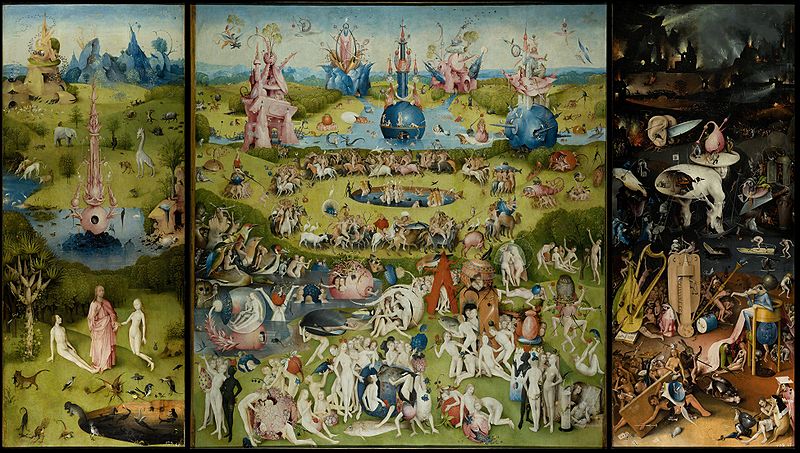
Bosch. Garden of Earthly Delights. "Against this background one may understand his identification with Kafka's oeuvre, which turns out mainly to be the rhyming of hints and interpretations in a reality in which the context for this work of art is constantly unraveled and woven afresh,(137) but always piecemeal, with no continuity which may turn into tradition, or progress: forever without concrete foundation. The whole of Benjamin's project relies here on the refusal to identify with the victorious side,(138) which shapes reality and writes its history. Benjamin's religious mission was to fight all opposing forces on behalf of the memory of the past and of its interpretation in the "now-time." The "now-time" expropriates the interpreter's space of existence from within the reality of the continuos march of victory of mere violence, which always wins - necessarily. Horkheimer was he who transformed this theme into an explicit position of Jewish theology,..." Read More; http://construct.haifa.ac.il/~ilangz/Utopia4.html
Considering their works is a different matter. I believe Bosch placed his own pessimistic view in the painting. People are in the hurried midst of doing nothing. They eat, speak, woo, ride horses in endless circles, crawl into eggs, and do a variety of useless activities. It was Bosch’s cynical statement about the behavior of mankind. In the end, the person or organization that the triptych was painted for desired a religious theme. A hymn of joy and praise to God would be perfect. The right and left panels illustrate a customary narrative. The central panel, arrayed with explosive color and imagery, is merely allegorizing the Psalm further than the front cover. The intense delight Bosch places in symbols and creative expertise is his own personal touch. Though we will never know if he was an alchemist, a sado-masochistic deviant, a closet homosexual, a member of a “free-love” society, Leonardo’s evil twin or whatever, we do know he was a great artist with an opinion he felt about the status of mankind, and the expertise to illustrate it. Read More: http://wcoventry0.tripod.com/id17.htm





 COMMENTS
COMMENTS
A great favourite and perfectly handled.
Thanks Dave!
only folly that persists unaddressed
falls short of glorifying paradise
for every excess there is an offering
and a blessing